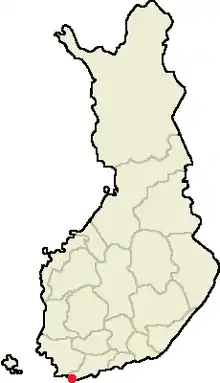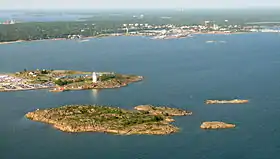Hanko Peninsula
The Hanko Peninsula (Finnish: Hankoniemi, Swedish: Hangö udd), also spelled Hango, is the southernmost point of mainland Finland. The soil is a sandy moraine, the last tip of the Salpausselkä ridge, and vegetation consists mainly of pine and low shrubs. The peninsula is known for its beautiful archipelago and long sandy beaches.

The town of Hanko is situated on the peninsula, as is the Port of Hanko.
The Baltic Sea proper is demarcated by a line from the Hanko Peninsula to the northwesternmost point of mainland Estonia. The waters east of this line are considered the Gulf of Finland.
The Battle of Gangut was fought outside the Hanko peninsula on 7 August 1714 ("Gangut" is the Russian transliteration of the Swedish name for the peninsula "Hangö udd").

The Hanko Peninsula has played a major part during times of war. Some of the Russian fortifications that were built as part of Peter the Great's Naval Fortress are located here. During the Finnish Civil War, the German Ostsee Division landed here in April 1918.
Following the Winter War, the peninsula was leased to the Soviet Union for 30 years as a naval base. However, the Soviets evacuated their 25,000 soldiers in the area during the Continuation War and it was retaken by the Finns and the Swedish Volunteer Battalion in December 1941.
